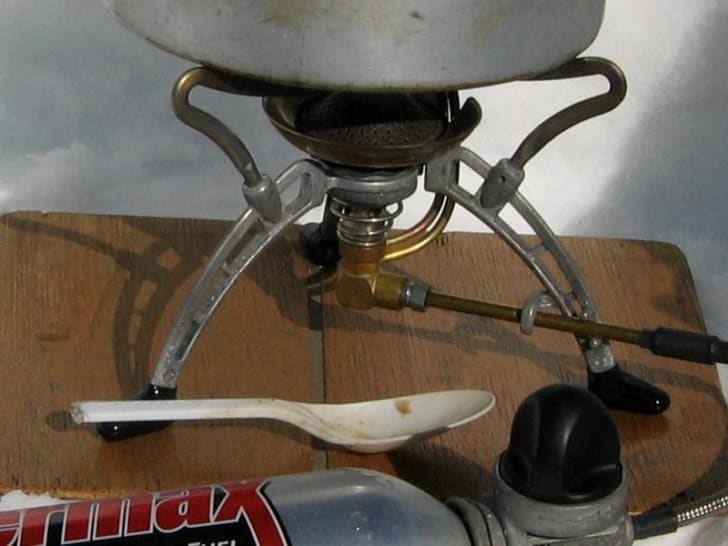Introduction
This article describes the design detail and performance of v4 of my DIY remote inverted-canister stove. Review Part 1 for background information about how this design evolved.
Pot Supports
How a stove supports the pot might seem like a minor detail, but it isn’t. A weak pot support can bend at the wrong moment, and there goes your dinner – plus a few other disasters – up to the point where you could end up with a destroyed tent.
Put the pot too close to the burner head, so the flame does not burn to completion, and you have a lot of CO coming off to poison you. Have a wobbly system there and you can even have the whole assembly falling over – with the flame still burning. Not an encouraging idea.
So we start with a little history:
V1 used a commercial burner head complete with its own integral supports, plus some pivoting legs underneath to hold the whole thing up. It was quite functional, but I didn’t make the burner head and that was disgruntling.
V2 used an external titanium wire tripod as pot support, which is a bit more stable but slow to set up. The stove support itself was based on a solid disk which was slow to set up on the mandatory base board. You could have problems if you used the small version of the tripod with a large heavy pot and ran the stove flat out.
V3 changed the titanium wire pot supports into radial things, so that only the inner ends of the titanium wires were near the flame and the supports themselves were vertical wires going down to the ground. However, manufacturing the stove body to secure those wire legs was very complex, and assembling the stove in the field took some time too.
Now, some commercial stoves use pivoting legs, and these are very easy to set up in the field. Rotating the legs out is simple. This was what I wanted. All I had to do was sort out the design constraints.
First, pivoting aluminum legs worked fairly well with V1 – but I only as a stove support, I didn’t use them for pot supports (I had concerns).

I worried that thin aluminum legs might have problems with the flames if they were used as pot supports, as well as being perhaps a bit wobbly. After all, I wanted the pot supports to be far more robust than, say, the old Pocket Rocket. On the other hand, Ti wire pot supports as in V3 can handle the heat and are fairly stiff, but how do you make simple rotating legs with them?
I diverted here to study the very fine Coleman Xtreme stove.

Member Exclusive
A Premium or Unlimited Membership* is required to view the rest of this article.
* A Basic Membership is required to view Member Q&A events




Home › Forums › DIY Ultralight Remote Inverted-Canister Winter Stove – Version 4, Part 1